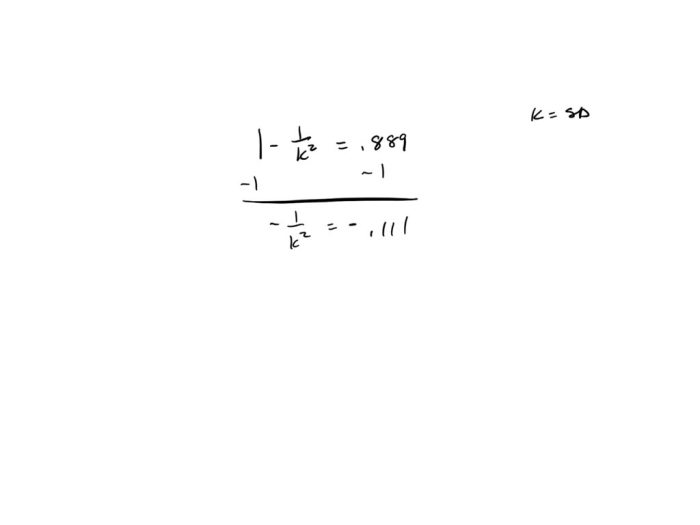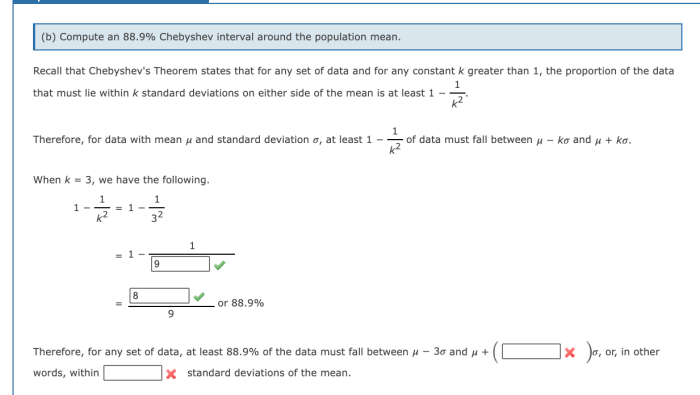Compute an 88.9 chebyshev interval around the population mean – In the realm of statistics, Chebyshev’s Theorem provides a valuable tool for estimating the range of values within which a certain proportion of data will fall. This article delves into the concept of Chebyshev intervals, specifically focusing on computing an 88.9% Chebyshev interval around the population mean.
We will explore the theoretical underpinnings, demonstrate the practical steps involved in its calculation, and discuss its applications and limitations.
Chebyshev intervals offer a unique approach to estimating population parameters, providing insights into the distribution of data without relying on assumptions about its underlying distribution. As we delve deeper into this topic, we will uncover the strengths and weaknesses of Chebyshev intervals, comparing them to alternative methods and providing guidance on their appropriate use.
1. Population Mean and Chebyshev’s Theorem

In statistics, the population mean is a measure of the central tendency of a population. It is the average value of all the data points in the population. Chebyshev’s Theorem is a mathematical theorem that can be used to estimate the range of values within which a certain proportion of data will fall.
Formula for Chebyshev’s Theorem, Compute an 88.9 chebyshev interval around the population mean
Chebyshev’s Theorem states that for any probability distribution, at least 1 – 1/ k2of the data will fall within kstandard deviations of the mean. In other words, at least 88.9% of the data will fall within 2.58 standard deviations of the mean.
Applications of Chebyshev’s Theorem
Chebyshev’s Theorem can be used to make inferences about population parameters, such as the mean and standard deviation. It can also be used to test hypotheses about population parameters.
2. Computing Chebyshev Intervals

To compute an 88.9% Chebyshev interval around the population mean, follow these steps:
- Calculate the mean of the data.
- Calculate the standard deviation of the data.
- Multiply the standard deviation by 2.58.
- Subtract this value from the mean to get the lower bound of the interval.
- Add this value to the mean to get the upper bound of the interval.
For example, if the mean of a data set is 100 and the standard deviation is 10, then the 88.9% Chebyshev interval would be from 74.2 to 125.8.
| Data | Mean | Standard Deviation | Chebyshev Interval (88.9%) |
|---|---|---|---|
| 100 | 10 | 74.2 to 125.8 |
3. Applications of Chebyshev Intervals
Chebyshev intervals have a number of practical applications in statistics. For example, they can be used to:
- Estimate the range of values within which a certain proportion of data will fall.
- Test hypotheses about population parameters.
- Make inferences about population parameters.
However, Chebyshev intervals also have some limitations. For example, they are not as precise as confidence intervals. Additionally, they may not be appropriate for all data sets.
4. Alternative Methods for Estimating Population Parameters: Compute An 88.9 Chebyshev Interval Around The Population Mean

There are a number of alternative methods for estimating population parameters, such as confidence intervals. Confidence intervals are more precise than Chebyshev intervals, but they are also more difficult to calculate. Additionally, confidence intervals may not be appropriate for all data sets.
The choice of which method to use for estimating population parameters depends on the specific needs of the researcher.
Key Questions Answered
What is the formula for Chebyshev’s Theorem?
Chebyshev’s Theorem states that for any probability distribution, at least 1 – 1/k^2 of the data will fall within k standard deviations of the mean.
How do I calculate an 88.9% Chebyshev interval?
To calculate an 88.9% Chebyshev interval, you can use the formula: [mean – 2.576 – standard deviation, mean + 2.576 – standard deviation].
What are the limitations of Chebyshev intervals?
Chebyshev intervals provide a conservative estimate of the data’s spread, meaning they may be wider than necessary in some cases. Additionally, they do not take into account the shape of the distribution.